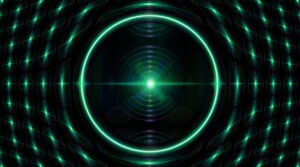The discovery of colossal structures like the Big Ring is reshaping established theories about the physics of the Universe.
A recent astronomical study has unveiled a colossal ring-shaped structure located billions of light-years from Earth. This formation, composed of galaxies and galaxy clusters that are not bound by gravity, spans roughly a billion light-years in diameter.
Super large structures, such as the newly discovered Big Ring, challenge the Standard Cosmological Model, the prevailing theory scientists use to explain the Universe’s evolution. This is because they test the limits of our current understanding of cosmic structure formation.
A blow to the Standard Model of Physics
The Standard Model, which includes the principles of cosmic inflation and the distribution of dark matter and dark energy, predicts certain scales and distributions for large-scale structures.
However, astronomers have been identifying ultra-large-scale structures for decades, with the first major discovery, the Great Wall, made in the 1980s. These structures range from hundreds of millions to nearly ten billion light-years across and are far larger than those predicted by the model, raising questions about how such immense formations could have developed.
It could also imply that our understanding of cosmological processes needs revising and might suggest the presence of new physics or laws of nature that our current model does not account for.
“When we look at the Big Ring from our vantage point on Earth, it looks like a collection of galaxies and galaxy clusters in the shape of a ring,” said Alexia Marie Lopez, a Ph.D. student in the University of Central Lancashire in the United Kingdom via email.
“On very large scales we expect matter to be spread evenly, so finding structures exceeding these large scales is somewhat unexpected,” she continued. “Finding many of these large structures is even more unexpected and then becomes difficult to explain with our current standard theories of the Universe.”
Discovering the Big Ring
The team identified the Big Ring using data from the Sloan Digital Sky Survey, which catalogs hundreds of thousands of quasars, which are galactic nuclei that host supermassive black holes. These cosmic behemoths accelerate their surrounding matter to enormous velocities forcing it to emit immense radiation, making quasars observable across vast distances.
It was quasars located behind the Big Ring that allowed the team to discover this ultra-large structure.
“We are not looking at the Big Ring in the same way that one would usually look at objects in the night sky: by looking at small, bright objects through a telescope,” explained Lopez. “Instead, we are seeing the contents of the Big Ring through a special method of looking at the ‘shadows’ in bright, distant objects cast from intervening faint matter. The shadows then tell us there are galaxies and galaxy clusters present.”
This shadow method had previously led the team to discover another vast structure, the Great Arc, which is of a similar size and located near the Big Ring. Both structures are almost the same distance from Earth, with an angular separation of only 12 degrees when viewed from our planet.
Their proximity suggests that these two formations might be part of an even larger cosmological system that could challenge existing cosmological models.
“Their proximity, their sizes and their interesting shapes (rings and arcs) are particularly interesting and could even be hinting at new physics beyond our current standard model,” said Lopez.
Shaking up cosmology
According to existing theories of elementary particles and gravity, the universe should appear homogeneous on scales of hundreds of millions of light-years, much like a fluid composed of stars and galaxies instead of atoms and molecules. However, the discovery of structures like the Big Ring, which spans billions of light-years, seems to contradict this expectation.
“We are now approaching a crossroads in cosmology where we must wonder if these structures are compatible with the standard theories in cosmology, or whether they are hinting at new physics beyond the standard model,” said Lopez. “We can’t yet know which this might be, but our study will hopefully help determine what their existence can tell us about cosmology.”
The research team believes that more detailed observations and a deeper analysis of existing data may provide answers. By gaining a better understanding of known ultra-large-scale structures and potentially discovering new ones, scientists could uncover vital information about the origins of these formations.
This, in turn, could offer insights into the fundamental laws of particle physics and gravity that drive the evolution of the universe.
“There is still a lot of data left to study, so one next step is to investigate the rest of this data and present what is found,” concluded Lopez. “We also find the Giant Arc and Big Ring system particularly interesting and so we will investigate the whole system further. We are intrigued by the possibility of an explanation from cosmic strings — defects in the very fabric of spacetime.”
Reference: A.M. Lopez, R.G. Clowes, and G.M. Williger, A Big Ring on the sky, Journal of Cosmology and Astroparticle Physics (2024). DOI: 10.1088/1475-7516/2024/07/055
Feature image credit: Placidplace on Pixabay












+ There are no comments
Add yours